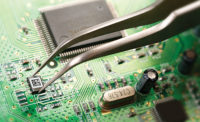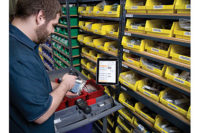Implanted electronic medical devices face an unusually benign environment in many respects. However, mechanisms still exist by which circuitry may degrade and even fail in service. Because of the extreme financial and ethical liabilities involved, engineers should carefully consider how to test for these failure mechanisms and, in particular, how to minimize the risk of them occurring. Preventing these failures has-or should have-direct implications for design and materials selection, and thus for the assembly approach.
Devices as directly critical to life and survival as pacemakers and defibrillators pose particular challenges in terms of quality and reliability. The electronics in such devices are invariably tested for the effects of multiple solder reflow and repair cycles, cleaning, storage conditions, and the various mechanical loads anticipated in handling and service. Nevertheless, concerns remain regarding the risk of a rare defect-driven early failure (‘infant mortality') not eliminated by inspection or burn-in.
Of particular concern are events not accounted for in accelerated life testing of a finite number of devices, such as shorting through gradual whisker growth or solder extrusion, or opens due to occasional voiding. Also of concern are subtle long-term degradations in mechanical robustness. Depending on metallurgy, supplier and assembler process control, and contamination, the strength of one or more bonds can degrade over time to the point where device robustness suffers more than accounted for.
Kirkendall Voiding
The vast majority of microelectronics packages are still made with gold (Au) wires bonded to aluminum alloy pads, a technique susceptible to a well-established long-term degradation mechanism known as Kirkendall voiding. Because this phenomenon tends to follow an Arrhenius dependence on temperature, it is expected a good bond will survive on the order of 10,000 years at body temperature, or about 37 C. However, voiding can be strongly enhanced by contamination of the bonding surface, and weakening may continue until a complete electrical open arises.
There have been reports that prolonged reaction between electroless Ni(P) and tin-lead (SnPb) solder may also lead to the formation of Kirkendall voids near the nickel (Ni) surface; but so far, practical concerns seem largely confined to lead-free solder applications rather than implantable electronics, which remain exempt from an immediate transition to lead-free materials.
A more complex mechanism has been observed in a few cases where a copper (Cu) pad on the opposite side of the joint from a nickel pad led to the build-up of a ternary (Cu,Ni)6Sn5 layer on top of the Ni3Sn4 (on the nickel). This structure is usually robust, but aging can lead to void growth at the Ni3Sn4/(Cu,Ni)6Sn5 interface.
The alternative to Ni/Au-coated solder pads is copper protected by either a thin organic layer (OSP), immersion Ag, immersion Sn, or preapplied solder (HASL). However, serious voiding has been observed in the Cu3Sn layer that forms when soldering with common no-lead solders or eutectic SnPb. Our research has shown this phenomenon to be somehow dependent on the copper, but not limited to a single plating chemistry. Furthermore, while it may vary between plating lots, it is not a simple question of contamination.
Importantly, the voiding is just as prevalent with eutectic SnPb as with a no-lead solder. Also, the apparent temperature dependence of accelerated test results does not always extend to lower temperatures, so extrapolations down to 50 C or less may overestimate time to failure by orders of magnitude. Overall, up to 10 percent of the copper samples investigated thus far have shown voiding at a level that might be a cause of concern. A major consortium-sponsored research effort is currently trying to define screening tests and develop remedies for this phenomenon.
This voiding should not be confused with bubbles that rise in liquid solder joints because of the evolution of volatiles in the fluxing reaction. A network of such voids might accumulate along the top, component pad surface and lead to the growth of fatigue cracks there. However, these voids usually do not grow appreciably by solid-state diffusion.
Electrolytic Ni/Au
Usually, nickel pads are coated with a thin layer of gold to protect them from oxidation. However, process variations may allow the nickel to oxidize beforehand, or for the gold to be porous so that a cold joint is formed. More insidiously, electrolytic Ni/Au may allow the formation of a SnPb solder joint that is indistinguishable from a good one in initial mechanical tests, but which degrades over time once in service. Luckily, this particular phenomenon is quantitatively predictable, although some product-specific testing may be needed for the specific loading conditions of concern.
The degradation in question is associated with the growth of a ternary (Ni,Au)Sn4 phase on the nickel surface during solid-state aging. Initial soldering leads to the complete dissolution of the gold layer and the precipitation of AuSn4 in the bulk of the solder joint. However, the ternary phase is thermodynamically more stable than this precipitate and therefore grows at the nickel surface at the expense of the AuSn4.
Because the Ni3Sn4/(Ni,Au)Sn4 interface is mechanically unstable, joint strengths decrease with increasing (Ni,Au)Sn4 thickness. As is the case with voiding, this is not of practical importance until the strength drops below the flow stress of the solder. During some recent testing, ultimate shear strengths started to decrease, and joint failures suddenly became much more abrupt as the thickness reached 1.3 microns after about 500 hours of aging. These changes were accompanied by a transition from ductile failure through the solder to brittle failure through the intermetallic layers on the contact pad.
Based on our quantitative understanding of the underlying mechanisms, we would predict a similar transition to brittle failure in a ball shear test after about 33 years at body temperature for these particular samples. However, this relatively long time corresponds to a maximum diffusion distance equal to an uncollapsed ball height of 24 mils. An actual assembly with collapsed solder joints, and perhaps smaller balls to start with, would not last nearly as long in a similar test. In a chip scale package (CSP) assembly, the total solder joint height is often less than 10 mils, and with similar amounts of Au on both the component and printed circuit board to start with, the corresponding time would be reduced to about 18 months!
Brittle failure in a conventional shear test is, of course, not necessarily a realistic method of predicting failure in an actual device, and the critical intermetallic thickness may be larger or smaller than 1.3 microns. On the one hand, a higher shock, or loading rate, may cause brittle failure with a smaller (Ni,Au)Sn4 thickness. On the other, medical devices will almost certainly have been designed to prevent loads from approaching the solder-flow stress characteristic of our room-temperature shear test. Still, aging will inevitably lead to weakening. Realistic manufacturing tolerances do not allow for the control of electroplated gold thicknesses to much less than 0.63 to 1.3 microns, so the ultimate (Ni,Au)Sn4 thickness may well approach 5 to 10 microns and the interface may become quite weak.
Note that the problem is not a factor with immersion Au (ENIG), for which the thicknesses are invariably much thinner. However this technology leads to other concerns, one of them deceptively similar to the above weakening effect in appearance.
ENIG and Black Pads
Immersion Au is a self-passivating process commonly used to protect electroless nickel, and thicknesses are automatically limited to 0.075 to 0.20 microns. The process is corrosive and requires significant additions of phosphorous or some other element to the underlying nickel to prevent excessive corrosion.
A unique and widely recognized concern is the so-called "black pad" phenomenon, a somewhat ubiquitous term that most generally refers to a lack of solderability of the Ni(P) surface due to a high amount of corrosion during the immersion Au process. An alternative mechanism by which a seemingly perfect solder joint may degrade over time was recently indicated by testing solder balls on ENIG surfaces in shear after various periods of aging at 150 C. Specifically, we found that some assemblies showed a transition to brittle failure at the pad surface after anywhere from 250 to 1,000 hours. In principle a gold thickness of 0.15 micrometer or more might be enough to cause the build up of more than 1.3 micrometers of (Ni,Au)Sn4 on the pad surface. However according to our predictive equation it should have taken much longer to do so and careful analysis showed no such layer.
Indications are that there is a correlation between the black pad phenomenon and the P concentration at the Ni(P) surface. A concentration of less than 8 percent to 10 percent is almost certain to give a problem, while concentrations of 15 percent to 16 percent are sometimes, but not always, accompanied by problems as well.
Microstructural analysis of our shear test samples did not show any obvious correlation between sensitivity to aging and the P concentration near the surface. We did find support for the suggestion that brittle failure may be associated with the growth of an additional phase between the Ni3P and the Ni3Sn4. However, we still do not know how to safely control the mechanism.
Tin Whiskers
In 1986 the FDA advised that a group of pacemakers from a single manufacturer had been found to fail catastrophically due to tin whiskers growing from the tin-plated case and shorting it to the crystal. In addition, whiskers caused the failure of a commercial satellite in 1988. The growth of whiskers from pure tin layers is thus a known concern in high-reliability applications.
Long-term storage of plated tin deposits at or slightly above room temperature has been seen to lead to the growth of single-crystal whiskers up to 9 millimeters long. This occurs in the absence of ambient humidity and electrical fields and should not be confused with dendritic growth. The phenomenon is sensitive to a large number of parameters, and it has proven extremely difficult to define a quantitative test protocol for accelerated aging.
Although various means of mitigating the problem have been established, it is expected that consistently preventing the growth of whiskers from a tin coating would require the simultaneous control of so many factors that it may be impractical, if not impossible, in a manufacturing environment. The only completely safe remedy may therefore be to not leave any pure tin surfaces unsoldered. Adding as little as 3 percent (by weight) of lead to the tin is commonly believed to prevent whisker formation, and the phenomenon is rare in SnPb solders.
Underfilling Pros and Cons
Defect-free encapsulation with a hard material such as a conventional flip chip underfill may well suppress whisker growth sufficiently to prevent electrical shorts. It will certainly protect encapsulated wire bonds and solder joints from mechanical loads and effectively eliminate the risk of failure due to reductions in bond strength. We caution only that encapsulation of second level solder joints has actually been seen to shift thermal mismatch stresses to first level interconnects to such an extent that these failed much sooner in cycling.
Flip chips are normally underfilled with a relatively rigid thermoset material to minimize solder joint fatigue in thermal excursions, whereas a repairable, softer material is often used for BGAs and CSPs. The latter material tends to leave the overall assembly more flexible and better able to resist delamination under mechanical loads. This is important because delamination will cause catastrophic failure once it reaches the first solder joint.
Unfortunately, despite its benefits, underfilling can also introduce a potential failure mechanism. Specifically, underfill flow and cure invariably leads to the occasional formation of small voids, with a particular tendency for some of these to become trapped between closely spaced solder joints. Subsequent reflows and long-term storage at temperatures as low as 80 C have been reported to cause solder to extrude into such voids. Of course, bridging to a neighboring joint is only a risk at relatively fine pitches. However, it is not yet clear whether years at 37 C could cause extrusions to grow long enough to pose a problem.
Finally, most underfills can degrade strongly under the aggressive cleaning used by some companies in the manufacturing of medical implants. When choosing an underfill material, engineers have to determine the effects of this cleaning on delamination, cracking and extrusion, both during repair and service.
Accelerated Testing and Remedies
Currently, the only realistic way of completely preventing problems with whiskers is to avoid leaving pure or almost-pure Sn surfaces unsoldered. Otherwise, underfilling should help. A hard underfill material is likely to provide the most effective whisker prevention, but hard underfills are usually not repairable and a truly soft material may reduce the risk and severity of solder extrusion into voids.
As for accelerated testing, the extrusion phenomenon does not seem sufficiently reproducible to allow the establishment of meaningful acceleration factors or the definition of test protocols. In addition, the underfill voids and cracks allowing for extrusion are often too fine to be detectable by inspection, even with an acoustic microscope. Manufacturers therefore have to rely on a general optimization of the design, materials selection and process parameters.
Although it has been suggested that proper control of plating parameters and ensuring a P content of around 10 percent may prevent black pad, the variability of the phenomenon is such that there isn't likely to be a realistic way to inspect or test for such problems. The only sure remedy would thus appear to be to avoid the use of ENIG in implantable medical devices.
It may be possible to use electrolytic Ni/Au pads for SnPb soldering. However, quantitative accelerated testing must involve the actual assembly configuration, as opposed to just solder balls. It must also reflect the actual mechanical loading to which a device will be subjected. A more conservative approach is to drive the (Ni,Au)Sn4 build-up on the contact pads to completion before testing, in which case no other thermal preconditioning is necessary.
In spite of everything, soldering to copper pads may still offer the best reliability, although the occasional voiding in the Cu3Sn remains a serious concern. We are in the process of defining semi-empirical screening tests to be applied to each incoming lot of printed circuit boards or component substrates, together with a conservative approach to the extrapolation of accelerated test results to service conditions. However, a complete mechanistic understanding and, hopefully, practical remedies will require a bit more work.





